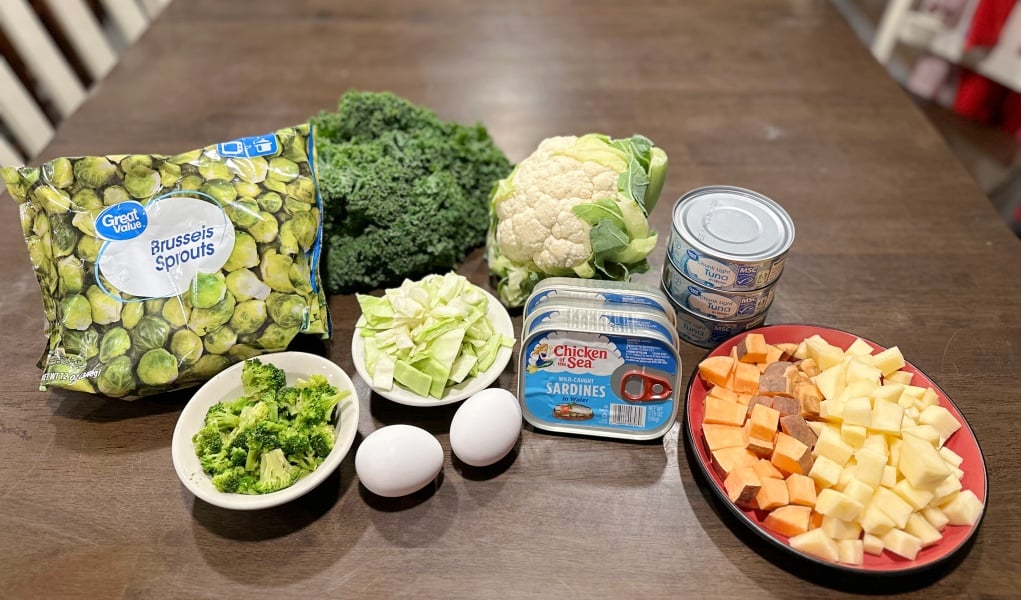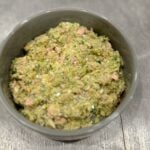We all know that the liver is a vital organ. It removes toxins and waste from the body and produces bile to help aid digestion. Feeding a homemade dog food for liver health is a great idea, even if you pup doesn't have a liver related condition.
Certain dog breeds including Golden Retrievers, Labradors, Schnauzers and Yorkshire Terriers are genetically predisposed to liver disease. Whether your dog is predisposed to liver problems or not, feeding a recipe that is good for liver health is a benefit for all dogs.
This recipe doesn't need to be the only recipe in your homemade dog food repertoire. You can incorporate this in the revolving recipes that you feed your pup. It will add a boost of nutrition and support liver health.
If your dog has been diagnosed with liver disease, your veterinarian has likely recommended a change in diet. While there are commercial dog foods for liver disease, a homemade diet could be a better option.
As long as you ensure the recipes are formulated to be nutritionally balanced, homemade dog food can be healthier and much more appealing to your pet than commercial kibble.
If you plan to feed homemade dog food for liver health, you need to talk to your veterinarian or a canine nutritionist first. It is imperative that the food you feed doesn't just address your pet's health condition, but also meets his overall health and nutritional needs.
A dog's dietary requirements vary based on a number of factors including health condition, weight, activity level, age, breed and much more. While this homemade dog food recipe may be nutritionally balanced for dogs, it won't meet the needs of every dog.
Homemade Dog Food for Liver Health

When a dog's liver gets compromised, the build-up of toxins and waste will affect other organs as well, leading to life threatening health problems. Liver disease in dogs can be treated with medication, a change in diet and close monitoring of the liver function.
Early detection is key to treating this problem. Thanks to the liver’s ability to regenerate itself, fast treatment can lead to a complete recovery.
You wouldn't be reading this article if you weren't concerned about your dog's liver health. Whether your dog has been diagnosed with liver disease, your veterinarian has warned you about your dog's predisposition to this condition, or the fact that you learned about your dog's predisposition through a canine DNA test, you need to start helping your pet immediately.
You will need to work with your veterinarian to come up with the best treatment plan for your dog's unique needs. They will guide you in finding the right medication, switching to a food for dogs with liver disease and setting up a schedule to test your pup's liver regularly.
Ultimately, the severity of your dog's condition will dictate the specific nutritional requirements needed in his homemade dog food for liver health. This is why it's so important to work with a veterinarian or trained canine nutritionist when choosing recipes.
PrintRecipe: Homemade Dog Food for Liver Health
Any changes to what your dog eats should be made with extra care and caution. The reason for this is because liver disease is susceptible. This means that if your dog receives too much or too few of specific nutrients, it could accelerate the progression of his condition.
- Prep Time: 15 minutes
- Total Time: 15 minutes
- Yield: 8 cups 1x
- Category: Cooked Food
- Method: Food Processor
- Cuisine: Dog Food
Ingredients
- 1 cup cabbage (chopped)
- ½ cup broccoli (chopped)
- ½ cup brussels sprouts
- ½ cup cauliflower (chopped)
- 1 cup rutabaga (chopped)
- 1 cup turnip (chopped)
- 1 cup kale (chopped)
- 3 cans tuna in water
- 2 hard boiled eggs
- 2 cans sardines in water
Instructions
Add the cabbage, broccoli, brussels sprouts, cauliflower, rutabaga, turnip, kale and boiled eggs to a food processor. Pulse until the ingredients are the consistency of canned dog food.
In a large bowl, combine the mixture from your food processor with the tuna and sardines. You don't need to drain the water, just dump the contents of the cans into the mixture and stir until equally combined.
Nutrition
- Serving Size: 1/2 cup
- Calories: 74
- Sugar: 1.1 g
- Sodium: 70 mg
- Fat: 2.9 g
- Carbohydrates: 2.7 g
- Fiber: .8 g
- Protein: 9.3 g
- Cholesterol: 70 mg
Serving Size Recommendation: You can serve this homemade dog food for liver health to your pet as soon as it has cooled. I recommend feeding about 1/2 cup of food for every 20-25 pounds of body weight.
This recommendation is for 2 servings per day. So, a 25-pound dog would eat about 1/2 cup in the morning and 1/2 cup in the evening.
This is just a guideline. Some dogs, like working dogs and very active breeds, will need more calories than this. Lazier pets and senior dogs may not need as many.
It's best to consult your veterinarian about the appropriate serving size for you dog. They will also help you evaluate meal to make sure it will meet your pet's unique nutritional needs. If necessary, they will assist you in choosing the best supplements and/or multivitamins to add.
How to store: You can store the leftover liver health dog food in an airtight container in the refrigerator for 3-5 days or freeze them, and they’ll keep for up to 3 months. Keep in mind that this recipe includes no preservatives, so that it won't last nearly as long as commercial dog food.
For More Information
We publish many homemade dog food and treat recipes every month. For more recipes, pet food cooking tips, and advice, see our “Recipes” section.If you're new to home-cooked dog food subject, I recommend you read more about “How Much To Feed” to understand serving sizes, “What Supplements To Use” to create well-balanced meals, and “How To Store” for tips on simple and easy homemade dog food storing in a fridge or a freezer.













